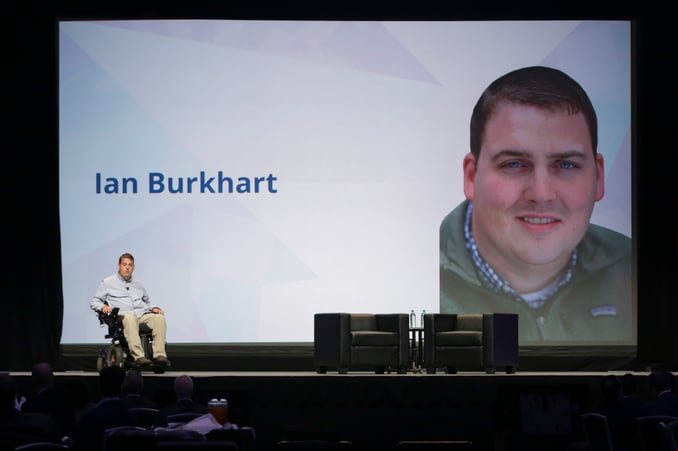This post is brought to you by Battelle
Imagine you are paralyzed, and are given the opportunity to regain control of a few key hand gestures. Which ones would you choose first? A tight fist? A handshake?
How about a credit card swipe?
That was the surprising answer Ian Burkhart gave when researchers from Battelle’s NeuroLife™ team asked him what he would like to work on next. Ian, who was paralyzed in a diving accident in 2011, is the first person to test the NeuroLife technology. Using a chip implanted in Ian’s brain, a sophisticated computer algorithm that interprets brain signals, and a specialized sleeve that sends those signals to Ian’s muscles, NeuroLife has given Ian the ability to consciously control his hand, wrist and fingers.
But mastering each gesture requires a lot of practice time for Ian and training for the computer algorithm that connects his brain to his muscles. After working on basic gestures such as opening and closing the hand, we asked Ian what he would like to work on next. Credit card swiping was the furthest thing from our minds—but for Ian, this simple gesture was an important step towards a future with greater independence.
Working on cutting-edge medical devices that address complex medical issues requires device developers to go beyond basic human factors research and human centric design principals. For the NeuroLife team, Ian has been much more than a subject or even a participant. Ian says, “With my experience in a clinical trial, I have been able to evolve from a participant to an active partner in the research process of making a medical device.” That has included suggesting new experiments and active problem solving with the research team.
This kind of partnership may not be necessary—or even desirable—for all types of medical devices. But for NeuroLife, it has been essential. NeuroLife brings together several factors that make patient partnership especially important:
- The technology is new and based on groundbreaking (and still evolving) science.
- The nature of the research and/or patient population does not lend itself to more traditional preclinical and clinical trial research.
- The device will be used for extended periods of time and become an intimate part of patients’ daily lives.
- Extensive feedback is needed from the patient in order to iterate and refine the device over time.
- Research sessions are long and require a high degree of patient engagement to be successful.
- Much of the success of the device is measured subjectively, by factors such as whether Ian “feels” in control of his movements and how satisfied he is with the results he attains.
There are many similar medical device development projects that would benefit from this “patient as partner” approach, in particular other cutting-edge assistive and rehabilitative technologies. The more innovative the technology, and the more extensively and intimately it will be used by patients, the more important it is to have the patient voice guide research efforts.
This means more than conducting user focus groups and contextual research. It means making study participants active members of the research team. Instead of a set research program in which all activities are dictated from researchers to patients, these patient partners will be engaged in a two-way dialogue that informs the direction of future trials and further iterations of the device.
This is a more active process than many medical device developers are used to. But when we make patients our partners, they can take us in surprising new directions. The result will be a medical device that is much better suited to the needs of the people who will be using it every day.


